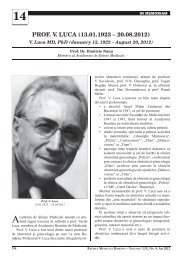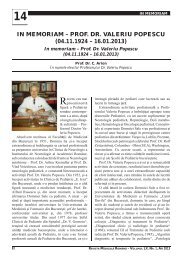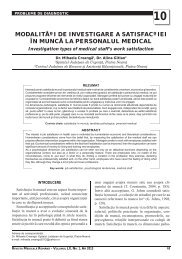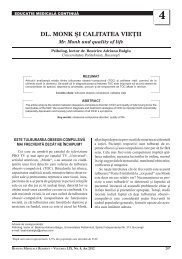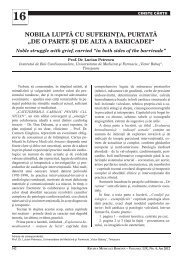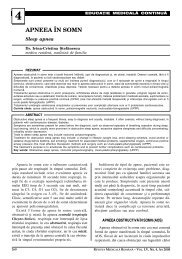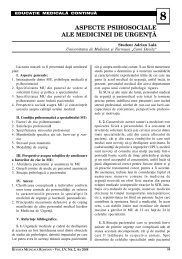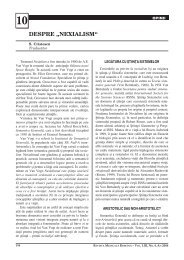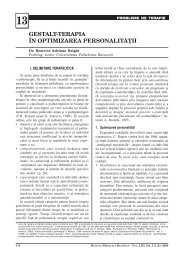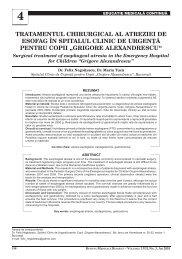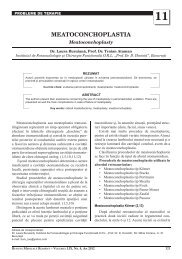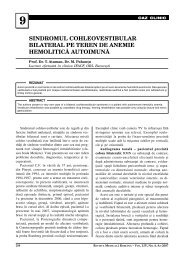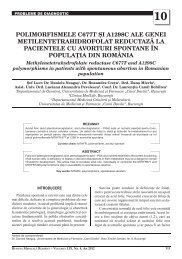You also want an ePaper? Increase the reach of your titles
YUMPU automatically turns print PDFs into web optimized ePapers that Google loves.
122<br />
(which is a frequent complication) must be<br />
monitored in order to urgently drain fl uid using a<br />
VP shunt. The follow-up of 3rd ventricle lesions<br />
must be monitored post-op. using native and<br />
contrast CT?<br />
If 20 years ago the spotlight was taken by the<br />
quad vitam p<strong>ro</strong>gnosis, today, surgeons focus on the<br />
p<strong>ro</strong>gnosis quad sanationem, meaning that the<br />
patient must not only live, but to have minimal<br />
neu<strong>ro</strong>-psychologic deffi cit as well.<br />
In these conditions, we believe the modifi cations<br />
we present to the classical 3rd ventricle transcallosal<br />
app<strong>ro</strong>ach offer a good outcome to III-rd ventricle<br />
tumor surgery.<br />
Regardless of the app<strong>ro</strong>ach used, III-rd ventricle<br />
tumors represent an important challenge in neu<strong>ro</strong>surgical<br />
pathology. Using modern imaging technology<br />
and instrument III-rd ventricle tumor<br />
app<strong>ro</strong>aches are used more oftenly and morbidity<br />
and mortality are d<strong>ro</strong>pping.<br />
Key words: III-rd ventricle, expansive p<strong>ro</strong>cess,<br />
transcallosal app<strong>ro</strong>ach, lateral app<strong>ro</strong>ach, anatomy.<br />
Extreme manifestati ons of hydati c disease in<br />
the Central Nervous System<br />
A. Mohan 1 , L. Eva 2 , D.A. Nica 3 , H. Moisa 4 ,<br />
A.V. Ciurea 4<br />
1 Oradea University, Faculty of Medicine,<br />
Department of Neu<strong>ro</strong>surgery, Oradea County Hospital,<br />
1 st Neu<strong>ro</strong>surgical Unit, Oradea<br />
2 „Gr. T. Popa“, University School of Medicine,<br />
Department of Neu<strong>ro</strong>surgery, N. Oblu Clinic Hospital,<br />
Iasi<br />
3 St. Pantelimon Clinic Hospital,<br />
Department of Neu<strong>ro</strong>surgery, Bucharest<br />
4 Ca<strong>ro</strong>l Davila University School of Medicine,<br />
Department of Neu<strong>ro</strong>surgery, 1 st Neu<strong>ro</strong>surgical Unit,<br />
Bagdasar-Arseni Clinic Hospital, Bucharest<br />
Int<strong>ro</strong>duction<br />
Hydatic disease (HD) is an anth<strong>ro</strong>pozoonosis<br />
caused by the larval cysts of Echinococcus granulosus,<br />
a small, cosmopolite, cyclophyllid cestode<br />
(tape worm) currently found th<strong>ro</strong>ughout the world.<br />
Despite the rise in occurrence, echinococcosis<br />
remains a very rare disease (less than 1 case per 1<br />
million inhabitants) in the continental United States<br />
and Northern and Western Eu<strong>ro</strong>pe. The incidence<br />
of cystic echinococcosis (hydatic disease) in endemic<br />
areas (the Mediterranean countries, the Middle<br />
East, the southern part of South America, Australia,<br />
New Zealand, and southern parts of Africa)<br />
REVISTA MEDICALÅ ROMÂNÅ – VOLUMUL LIX, NR. 2, An 2012<br />
ranges f<strong>ro</strong>m 1 to 220 cases per 100,000 inhabitants.<br />
Primary target organs were considered to be the<br />
liver (60-70%), lungs (15-25%), less frequently the<br />
kidneys, spleen, central nervous system (2%) and<br />
muscles. Solitary cysts appear in 70% of all patients.<br />
The cerebral hemispheres offer good conditions<br />
for the expansive development of the hyatic cyst<br />
which will be able to g<strong>ro</strong>w to impressive dimensions.<br />
This paper regarding unusual locations of<br />
hydatidosis of the central nervous system (CNS)<br />
has the purpose of showing clinicians that hydatic<br />
disease can manifest itselft th<strong>ro</strong>ugh various manifestations<br />
that are out of the ordinary.<br />
Materials and methods<br />
The main topic of the paper consists of rare sites<br />
and presentations of hydatic disease in the CNS.<br />
Using our own cases and cases taken f<strong>ro</strong>m the literature<br />
we focus our attention on HD positioned in<br />
the ventricles, in the cerebellum, in the brainstem<br />
and in the orbit. We will also present extremely rare<br />
hydatic disease positions such as intradural, extradural,<br />
subdural, intracranial and intrarachidian (intraosseous),<br />
cysternal, sinusal, thalamic, in the<br />
brainstem etc. In endemic countries with hydatic<br />
disease, cases in which a compressive pathology of<br />
the spine and spinal cord is encountered, should<br />
consider the larvar form of EG as a possible pathologic<br />
factor.<br />
The classical surgical treatment that is recommended<br />
today involves the method described by<br />
Arana-Iniguez while orbital cysts should be removed<br />
using a declive water-based dissection. Besides<br />
surgery, hydatic disease is generally treated<br />
with pharmaceutical agents which will p<strong>ro</strong>tect the<br />
whole body. The <st<strong>ro</strong>ng>medica</st<strong>ro</strong>ng>l treatment (AAA ac<strong>ro</strong>nym<br />
- Antiparasitic, Anticonvulsive and Antiedematous)<br />
should precede and follow the surgical interventions.<br />
Any patient in which a hydatic cyst is found,<br />
regardless of the position of the cyst, should undergo<br />
a minimal all-body CT scan and a CNS MRI<br />
scan to remove any risk.<br />
Key words: Echinococcus granulosus, unusual<br />
manifestations, skull vault, intradural, extradural,<br />
subdural, sellar, parasellar, basal ganglia, vascular<br />
sinus, brainstem, spinal implications, MRI, CT-all<br />
body, surgical treatment.



